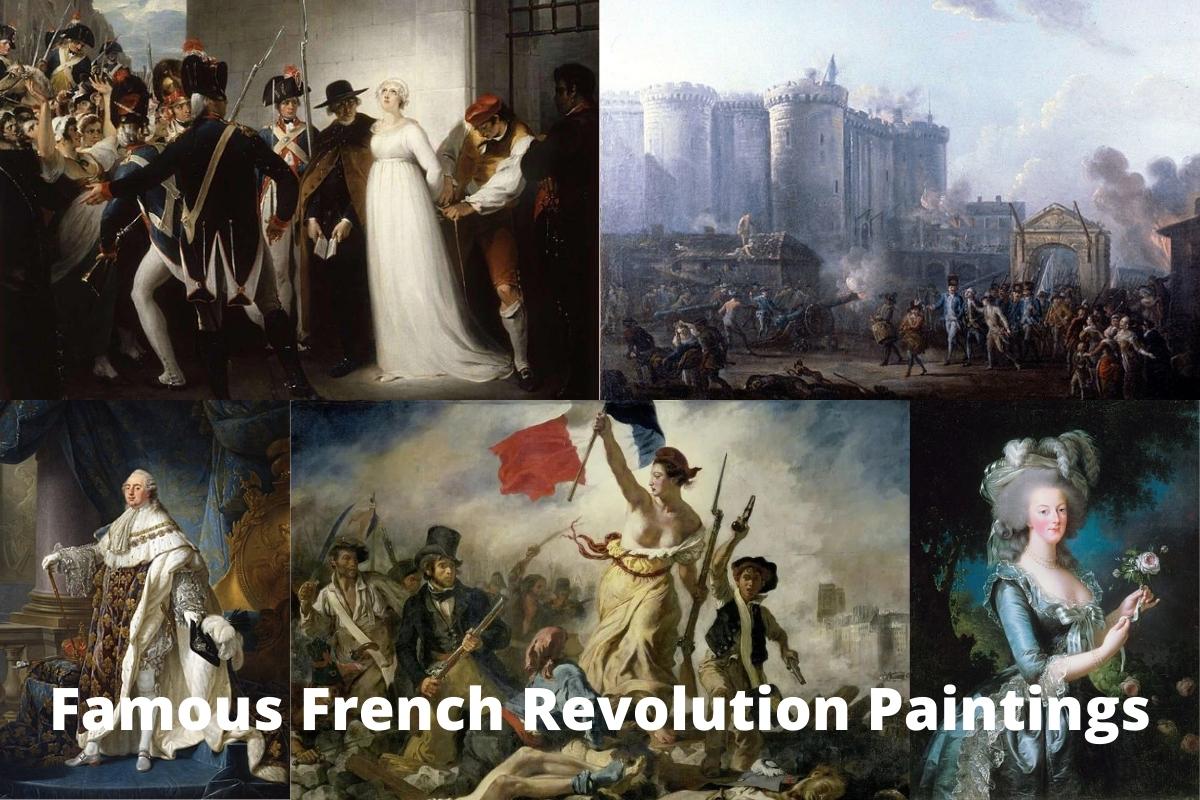The French Revolution was a period of profound political and social upheaval in France that started with the Estates General in 1789 and concluded in November 1799 with the foundation of the French Consulate.
Many of its concepts are now regarded core liberal democratic values, while terms like liberté, égalité, fraternité resurfaced in subsequent revolts, like as the 1917 Russian Revolution, and spurred movements for the abolition of slavery and universal suffrage. The principles and institutions it established continue to dominate French politics to this day.
The reasons are widely acknowledged to be a mix of social, political, and economic issues that the current administration was unable to control.
Below you will find some of the best examples of French Revolution art that captures both the ordinary people caught up in the cause and the aristocracy that they overthrew plus Napoleon’s coronation.
Famous French Revolution Paintings
1. Liberty Leading the People – Eugène Delacroix
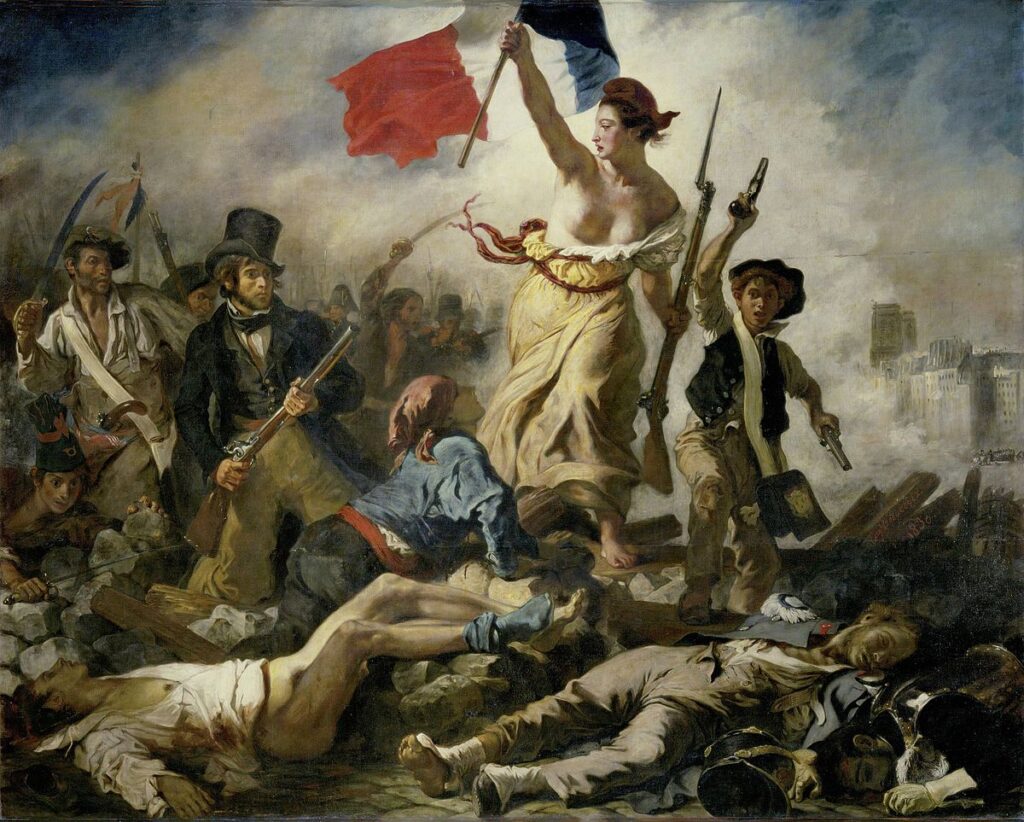
Since the French Revolution and up to the current day, French culture has been replete with allusions to Liberty.
The artwork Liberty Leading the People by Eugène Delacroix is possibly the most famous French Revolution picture ever created, commemorating the toppling of King Charles X of France in July of 1830.
Also Read: Famous Paintings in Paris
Later that year, Delacroix completed the painting, which depicts spectacular images of French revolutionaries engaged in a battle—some of whom are injured and laying on the ground—surrounding Lady Liberty as she continues to fight.
One of the most famous paintings in French history, it depicts a fierce conflict between the king’s adherents and the ordinary people of France. With the French flag in one hand and a gun in the other, Liberty, who is symbolized by a lovely lady, leads a charge into the battle.
In one hand, the woman is carrying a rifle, while in the other, she is waving a French flag. This painting is widely regarded as one of the most inspiring romanticism paintings, and it is without a doubt Delacroix’s most renowned work.
2. The Death of Marat – Jacques-Louis David
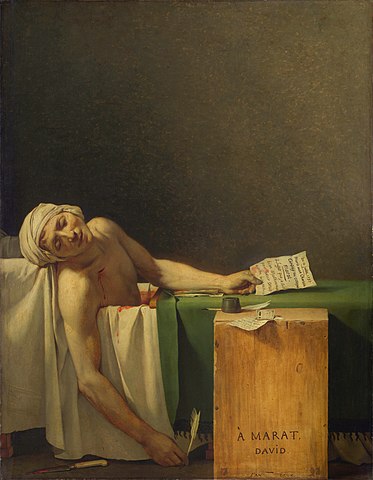
Jean-Paul Marat was a well-known figure in the late 1700s who is credited with spearheading the French Revolution. He was a journalist who subsequently became a politician, and his death represented a watershed moment in the struggle to wrest power from affluent aristocracy.
A lady stabbed Marat to death because she sympathized with a group that Marat had almost completely eradicated.
The death of Marat was shown in a painting called The Death of Marat, which is today regarded a notable Neoclassical masterpiece.
The picture was produced by Jacques-Louis David in 1793, only months after Marat’s death, as a tribute to the political figure’s life and efforts to fight for the core cause that would drive the deadly revolution.
David is known as one of the most prolific painters of the Neoclassical period, with many of his paintings depicting historical events. A dying Marat is seen in this artwork, reclining in a bath with a message clutched in his hand. The phrases on the paper include a message addressed to his assailant, Charlotte Corday.
3. The Tennis Court Oath – Jacques-Louis David
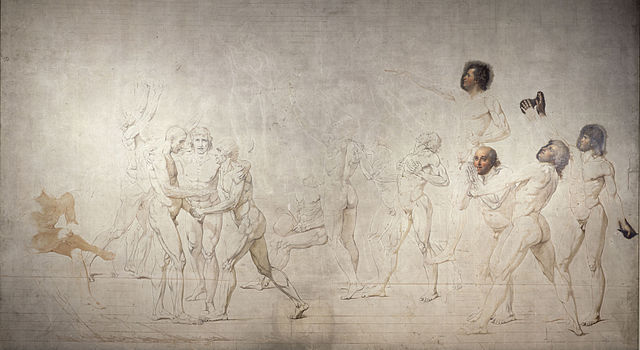
The Tennis Court Oath is an unfinished painting by Jacques-Louis David that depicts the eponymous Tennis Court Oath at Versailles, one of the founding events of the French Revolution. It was created between 1790 and 1794.
David was never able to complete the work, which spans 400 by 660 cm and is currently housed at the Musée national du Château de Versailles due to political reversals and financial problems.
Also Read: 18th Century Paintings
As a gesture of solidarity for Bailly, all of the deputies are seen looking at him. Martin-Dauch, the sole man who refused to take the oath, is shown in the bottom right hand corner, providing a contrast to the overall joy.
David also sketched all of the faces in great detail so that each character could be identified. Large windows with smiling public personalities may be seen above.
An oath, like in David’s own The Oath of the Horatii, had a holy importance in the 18th century and promised a person would be true to their word. Collective oaths, such as the tennis court oath, were regarded a factor in national unity and unanimity during the French Revolution.
The tennis court oath — pre-Romantic, near-unanimous, nearly entirely middle-class, and devoid of popular violence – was widely seen as a harbinger of the 1789 revolution, demonstrating that national sovereignty was based on human choice.
4. The Coronation of Napoleon – Jacques-Louis David
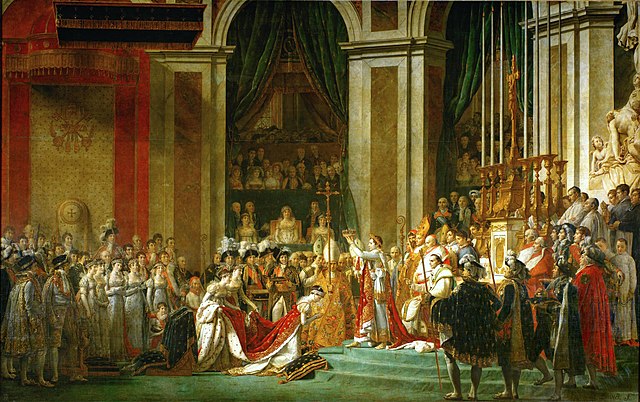
Napoleon’s Coronation is an 1807 painting by Jacques-Louis David, Napoleon’s official painter, depicting Napoleon’s coronation at Notre-Dame de Paris.
The oil painting is over 10 meters (33 feet) wide by little over 6 meters (20 feet) tall, with a breadth of more than 10 meters (33 feet). The painting is on display at the Louvre Museum in Paris.
In September 1804, Napoleon orally commissioned the work, and David started work on it on December 21, 1805, in the derelict chapel of the College of Cluny, near the Sorbonne, which served as a workshop. With the aid of his apprentice Georges Rouget, he finished the work in January 1808.
5. The Emperor Napoleon in His Study at the Tuileries – Jacques-Louis David
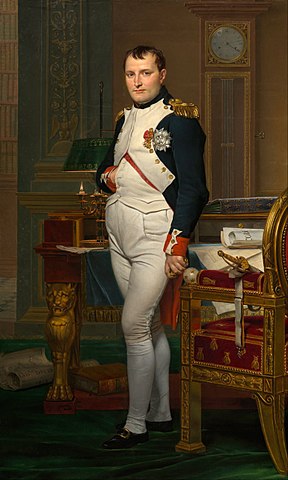
This painting shows Napoleon I of France in uniform at his Tuileries Palace study. Napoleon is unlikely to have posed for the portrait, despite the great attention to detail.
It is a vertical format and represents Napoleon in the Imperial Guard Foot Grenadiers uniform at three-quarters life size (blue with white facings and red cuffs).
In addition to his Légion d’honneur and Order of the Iron Crown insignia, he wears gold epaulettes, white French-style culottes, and white stockings. His right hand is buried in his jacket, and his gaze is fixed on the audience.
It was commissioned in 1811 and completed in 1812 by Alexander Hamilton, 10th Duke of Hamilton, a Scottish aristocracy and Napoleon admirer.
It was sold in 1882 to Archibald Primrose, 5th Earl of Rosebery, from whom it was acquired by the Samuel H. Kress Foundation in 1954, who presented it to the National Gallery of Art in Washington, D.C., where it now hangs.
6. Louis XVI, king of France and Navarre, wearing his grand royal costume – Antoine-François Callet
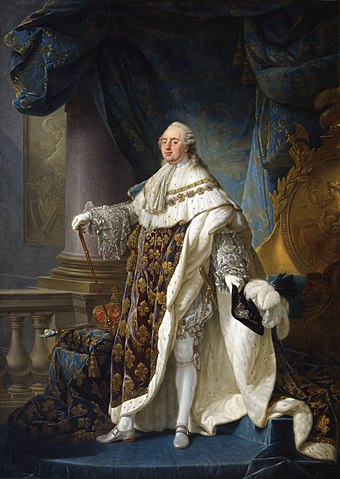
Antoine-François Callet, also known as Antoine Callet, was a French portrait and allegorical painter who served as Louis XVI’s official portraitist.
This is Versailles’ biggest portrait of Louis XVI. This monarch is much less well-represented in museums than Louis XIV and Louis XV, particularly in full-length pictures.
The painting shows the monarch in the full pomp of royal clothing for the time period.
7. Portrait of a Revolutionary – François Sablet
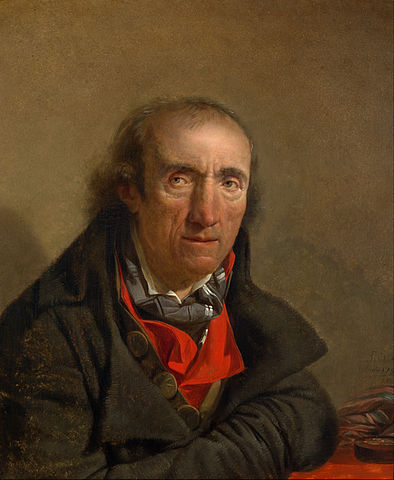
During the French Revolution, a new type of portraiture emerged: the old bon patriot (good patriot).
During the period of national crisis between 1789 and 1794, a considerable number of young Frenchmen were drafted into the military, leaving older generations to serve in the home guard and perform other civic obligations.
The red, white, and blue combination of his waistcoat, undershirt, and cravat, a circular box, maybe housing a badge of office or a cockade, and a tricolore belt to the side are all indicators of his revolutionary credentials in this unidealized picture of an elderly man.
8. Marie-Antoinette with the Rose – Louise Elisabeth Vigée-Lebrun
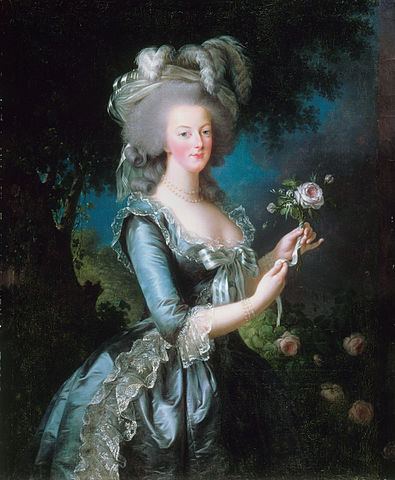
Marie Antoinette with a Rose was painted by Élisabeth Vigée Le Brun, the court painter of Queen Marie Antoinette of France. On May 31, 1783, Vigée Le Brun registered at the Académie Royale de Peinture et de Sculpture.
Marie Antoinette commissioned her to submit a picture of herself for the forthcoming Salon that year. She wore a chemise to play the queen.
During the period when the queen stayed at the Petit Trianon, outside of the palace, the chemise was copied from the queen’s favorite Parisian fashion seamstress Rose Bertin.
Visitors to the Salon were taken aback because they considered it was inappropriate to show a queen of France in such garb. The image was then withdrawn from the Salon.
The artist made five later copies with changes in attire, such as with a hat or in a muslin dress. The original portrait, in a chemise, seems to have been lost, but the artist produced five subsequent versions with variations in costume, such as with a hat or in a muslin dress.
9. Storming of the Bastille and arrest of the Governor M. de Launay – Jean-Baptiste Lallemand
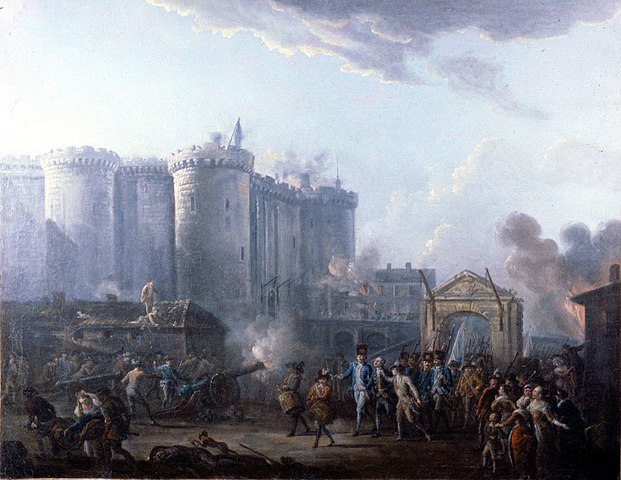
The Storming of the Bastille took place on the afternoon of 14 July 1789 in Paris, France, when revolutionaries stormed and took possession of the medieval armory, castle, and political jail known as the Bastille. The Bastille signified royal power in the heart of Paris at the time.
The jail had just seven prisoners when it was stormed, but revolutionaries saw it as a symbol of the monarchy’s misuse of power, and its collapse was a turning moment in the French Revolution.
The 14th of July is France’s national holiday, known as Bastille Day in English.
Under de Launay, the Bastille’s permanent garrison comprised of around 80 invalides (veteran military pensioners) who were no longer fit for regular army duty. They were reinforced by thirty Swiss grenadiers from the Salis-Samade Regiment two days before the 14th of July.
De Launay was apprehended and stripped of his sword and rank baton. One of the insurgents’ commanders, soldier (future general) Pierre-Augustin Hulin, was meant to transport him to the Hôtel de Ville.
On the way there, however, the enraged throng attacked the governor, thrashed him, and finally murdered him by slashing him with knives, swords, and bayonets and shooting him once.
The actual killing was said to have occurred near the Hôtel de Ville, when the distraught and mistreated de Launay shouted out “Enough is enough! Allow me to perish” Desnot, an unemployed chef, was kicked in the crotch.
Mathieu Jouve Jourdan, a butcher, sawed off Launay’s head after the murder. It was mounted on a pole and carried for many hours through the streets before being dumped into the Seine the following day.
10. Marie-Antoinette Being Taken To Her Execution – William Hamilton
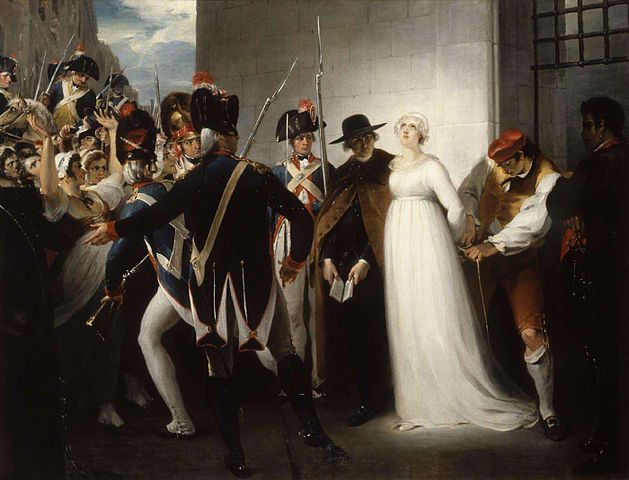
A renowned widow awaited her final daybreak in a drab cell at La Conciergerie in the early hours of October 16th, 1793, as despised by some as adored by others.
Separated from her children and her husband, who had long since been killed, Prisoner 280 had suffered a harrowing trial, with allegations ranging from incest to treason, and the conclusion had never been in question, her doom predetermined long before.
Marie Antoinette, the widowed Queen Consort of France and Navarre, was the lady in question and her execution was one of the defining moments of the French revolution.

